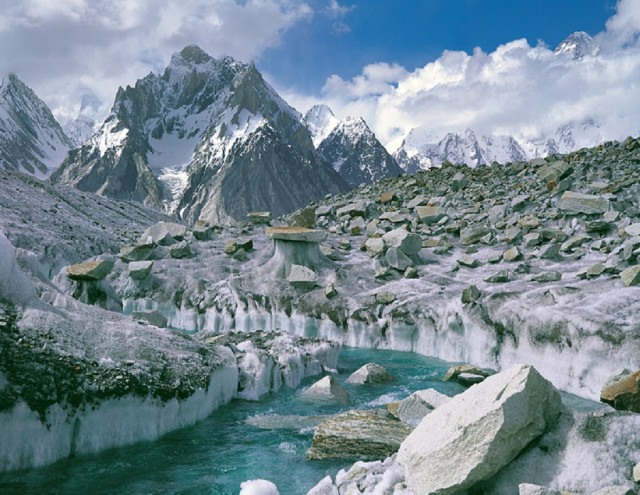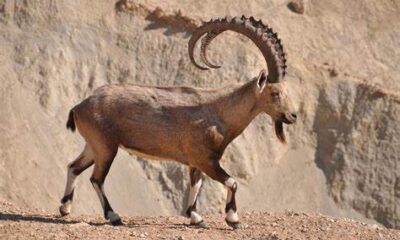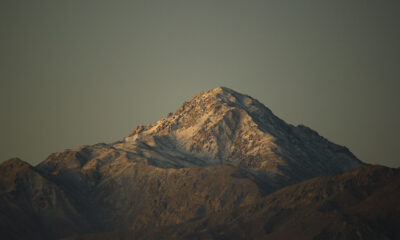Article
Gondogoro Glacier: A Majestic Icy Wilderness in Pakistan’s Karakoram Range
Published
9 months agoon
By
EDITOR
The Gondogoro Glacier, a stunning and lesser-known glacier, lies in the heart of Pakistan’s Karakoram Range. Renowned for its rugged beauty, it offers adventurers and mountaineers a challenging yet rewarding experience, set against the backdrop of some of the world’s highest and most imposing peaks. Gondogoro Glacier, though often overshadowed by nearby giants like the Baltoro Glacier and the mighty K2, is a treasure for those seeking the raw allure of nature in one of the most remote regions on earth.
Geographic Location and Overview
The Gondogoro Glacier is located in the Hushe Valley in the Ghanche District of Gilgit-Baltistan, Pakistan. It flows from the southern side of the Karakoram Range, stretching over 20 kilometers. The glacier is primarily fed by snowmelt from the surrounding peaks, including the famous Gondogoro La, a high mountain pass that stands at an elevation of approximately 5,585 meters (18,323 feet) and serves as a challenging yet exhilarating route for climbers.
Gondogoro La is the connecting point between the Gondogoro Glacier and the Baltoro Glacier, one of the largest glaciers outside the polar regions. The pass provides access to some of the most breathtaking views in the Karakoram Range, offering stunning panoramas of four of the world’s fourteen 8,000-meter peaks: K2, Broad Peak, Gasherbrum I, and Gasherbrum II. This makes the glacier a popular destination for trekkers and climbers seeking a more adventurous alternative to the traditional Baltoro Glacier trek.
Mountaineering and Trekking: A Gateway to Adventure
The Gondogoro Glacier and the pass it feeds into are integral parts of one of the most famous and demanding trekking routes in the world—the Gondogoro La Trek. This trek is often undertaken as part of the more extensive Baltoro Glacier and K2 Base Camp expeditions. For experienced trekkers, the Gondogoro La route adds an extra layer of challenge and excitement to the expedition, as it requires technical skills, the use of ropes, crampons, and ice axes, and the ability to traverse crevasses and steep ice slopes.
The trek typically begins in the village of Hushe, following the glacier up to Gondogoro La, where climbers cross over into the Baltoro Glacier, one of the most famous trekking routes in the Karakoram Range. Climbers face steep ascents, precarious ridges, and icy conditions as they make their way to the top of Gondogoro La, but the reward is a view of the surrounding peaks that is unparalleled anywhere in the world.
Due to the technical difficulty and unpredictable weather conditions, the Gondogoro Glacier and La are recommended for only experienced climbers and trekkers who are well-prepared for the harsh and often dangerous environment. The pass is only open for a short window during the summer months, typically from June to August, when the weather is most favorable. Even then, conditions can change rapidly, making the trek one of the most challenging in the region.
Natural Beauty and Glaciological Importance
The Gondogoro Glacier is a pristine and untouched environment, surrounded by towering peaks, sheer rock faces, and icefalls that create a dramatic and awe-inspiring landscape. The glacier is part of the larger Karakoram system, which includes some of the longest glaciers outside of the polar regions and is home to some of the highest and most difficult mountains in the world.
The glacier’s surface is a complex mosaic of ice, snow, and moraine (rock debris carried by the glacier), creating an ever-changing landscape that shifts with the seasons. The harsh and extreme conditions of the glacier have helped preserve its natural beauty, with little human impact beyond the occasional climber or trekker passing through the region.
The Gondogoro Glacier also holds significant glaciological importance. Like other glaciers in the Karakoram Range, it plays a crucial role in the region’s hydrology, feeding into rivers and streams that are vital to the ecosystems and human populations downstream. Unlike many glaciers around the world, which are retreating due to climate change, some glaciers in the Karakoram, including Gondogoro, have shown signs of stability or even slight growth in recent years, a phenomenon known as the “Karakoram Anomaly.”
Challenges and Environmental Concerns
While the Gondogoro Glacier remains relatively pristine compared to more heavily visited areas, it is not immune to the challenges that face high-altitude environments around the world. Increased trekking and climbing activity in recent years have raised concerns about the potential impact of tourism on the fragile ecosystem. Waste left behind by trekkers and climbers, as well as the erosion of trails and campsites, pose a threat to the environment if not managed properly.
Additionally, while the Karakoram Anomaly has resulted in some glaciers in the region remaining stable, the long-term impacts of climate change on the Gondogoro Glacier are still uncertain. Rising temperatures and changing weather patterns could eventually lead to the glacier’s retreat, with potentially serious consequences for the water supply in the region.
Efforts are being made by local authorities, environmental organizations, and trekking companies to promote sustainable tourism practices in the area. Clean-up expeditions, responsible trekking guidelines, and education for visitors are all part of a broader effort to minimize human impact on the glacier and preserve its natural beauty for future generations.
You may like
-


The Chiltan Ibex: A Rare Treasure of Balochistan
-


MANGO HEALTH BENEFITS NUTRITION
-


“Rising above the rugged terrain of Balochistan, Koh-i-Chiltan stands as a symbol of mystery and resilience.”
-


Aik Qaum, Aik Sath | Pakistan Zindabad | Pakistan Day Song | 23rd March 2024 | AIKQAUM.COM
-


Nation celebrates Pakistan Day today with traditional zeal
-


Pakistan Day: A Reminiscence of the Heroic Struggle of Muslims of the Subcontinent
Article
The Chiltan Ibex: A Rare Treasure of Balochistan
Published
1 month agoon
April 16, 2025By
EDITOR
The Chiltan ibex (Capra aegagrus chiltanensis), a subspecies of the wild goat, is one of the most unique and endangered animals native to Pakistan. Found exclusively in the rocky highlands of the Chiltan range within the Hazarganji-Chiltan National Park in Balochistan, this elusive animal represents the region’s rich biodiversity and ecological heritage.
Physical Characteristics
The Chiltan ibex is a strikingly beautiful species, with a robust, muscular build perfectly suited for navigating steep and rocky terrains. Males are particularly distinctive, boasting impressive curved horns that can grow up to 30 inches (76 cm) in length. Their coat is light brown, with a darker stripe running along their back and legs, providing excellent camouflage in their arid mountainous habitat.
Females are smaller in size with shorter, more slender horns, and their coloration is less pronounced, blending seamlessly into their surroundings. This camouflage helps protect them and their offspring from predators such as wolves and large birds of prey.
Habitat and Range
The Chiltan ibex inhabits the rugged, semi-arid regions of the Chiltan range, located within the Hazarganji-Chiltan National Park, southwest of Quetta. These high-altitude areas, ranging from 1,500 to 3,200 meters above sea level, are characterized by rocky cliffs, sparse vegetation, and extreme weather conditions.
The ibex is well-adapted to this challenging environment, where it feeds on grasses, shrubs, and the leaves of juniper trees. Its ability to climb steep slopes and jump across narrow ledges gives it a unique advantage in escaping predators and surviving in such inhospitable terrain.
Behavior and Social Structure
Chiltan ibexes are diurnal, meaning they are active during the day. They are typically found in small groups, with herds consisting of females and their young. Males are more solitary, joining herds only during the breeding season, which occurs in the late autumn and winter months.
During this time, males engage in dramatic displays of strength to compete for mating rights, including horn clashing and dominance rituals. After a gestation period of around six months, females give birth to one or two kids in spring, when food availability is higher.
Conservation Status
The Chiltan ibex is classified as endangered due to its restricted range, habitat loss, and poaching. Habitat degradation caused by overgrazing, deforestation, and human encroachment poses significant threats to its survival.
Historically, the ibex faced heavy hunting pressure for its horns, considered a symbol of prestige, and for its meat. Although hunting is now banned in the national park, illegal poaching remains a concern.
Conservation Efforts
To protect the Chiltan ibex and its fragile ecosystem, the Hazarganji-Chiltan National Park was established in 1980. Spanning over 32,500 acres, the park provides a safe haven for the ibex and other wildlife, such as wolves, foxes, and birds of prey.
Conservation efforts include:
- Anti-Poaching Measures: Increased patrolling and strict enforcement of hunting bans have helped reduce poaching incidents.
- Habitat Restoration: Programs to control overgrazing and reforest juniper woodlands are underway to restore the ibex’s natural habitat.
- Public Awareness Campaigns: Local communities are being educated about the importance of biodiversity and the role of the Chiltan ibex in maintaining ecological balance.
- Eco-Tourism Initiatives: Promoting responsible tourism generates revenue for conservation projects and raises awareness about the ibex’s plight.
Ecological Importance
The Chiltan ibex plays a vital role in its ecosystem as both a grazer and prey species. By feeding on shrubs and grasses, it helps maintain vegetation balance, preventing overgrowth and contributing to soil health. At the same time, it serves as a food source for predators, sustaining the natural food chain.
Protecting the ibex is not just about saving a single species—it’s about preserving an entire ecosystem that supports numerous forms of life, from tiny insects to apex predators.
Cultural Significance
For the people of Balochistan, the Chiltan ibex is more than just a wild animal; it is a symbol of the region’s natural beauty and resilience. Local folklore often intertwines with the ibex, celebrating its agility and strength. The species also draws international attention, making it a flagship for wildlife conservation in Pakistan.
The Future of the Chiltan Ibex
While conservation efforts have shown promise, the Chiltan ibex remains vulnerable. Protecting this rare species requires continued collaboration between government agencies, conservation organizations, and local communities.
By safeguarding the Chiltan ibex, we not only preserve a unique animal but also protect the fragile ecosystem of Balochistan, ensuring that future generations can marvel at the beauty and resilience of this incredible species.
The Chiltan ibex is a testament to nature’s ability to adapt and survive in the harshest of environments. As efforts to protect it continue, this majestic animal stands as a beacon of hope for wildlife conservation in Pakistan.
Article
“Rising above the rugged terrain of Balochistan, Koh-i-Chiltan stands as a symbol of mystery and resilience.”
Published
1 month agoon
April 16, 2025By
EDITOR
Koh-i-Chiltan, located in the rugged terrain of Balochistan, Pakistan, is not just a striking natural feature but also a site steeped in folklore, mysticism, and ecological significance. Rising to a height of approximately 3,194 meters (10,479 feet), it is the third-highest peak in the Chiltan range, forming part of the Sulaiman Mountain system. The mountain holds a commanding presence in the landscape and attracts mountaineers, nature lovers, and those intrigued by its legends.
Geography and Location
Koh-i-Chiltan is situated within the Hazarganji-Chiltan National Park, about 20 kilometers southwest of Quetta, the provincial capital of Balochistan. The name “Koh-i-Chiltan” translates to “The Mountain of Forty Spirits,” derived from local folklore that has become intertwined with its identity.
The surrounding park, spread across 32,500 acres, is a semi-arid region characterized by rugged cliffs, deep ravines, and sparse vegetation. The area is home to a diverse ecosystem, ranging from juniper forests to an array of fauna, including the Chiltan markhor, a rare wild goat species named after the mountain.
The Legend of the Forty Spirits
The legend of Koh-i-Chiltan is one of the most captivating tales of the region. According to local folklore, the mountain is haunted by the spirits of forty abandoned children. The story goes that a couple, unable to have children, sought help from a mystic who blessed them with forty babies. Overwhelmed by the burden of raising so many children, the couple is said to have abandoned them on the mountain.
The children, according to the legend, were nurtured by the mountain itself and eventually transformed into spirits. Locals believe these spirits still guard the mountain, and stories abound of mysterious voices, sightings, and unexplainable phenomena experienced by those who venture into the area.
This haunting narrative has contributed to the mountain’s mystique, drawing spiritual seekers and adventurers alike to experience its enigmatic aura.
Ecological Importance
Koh-i-Chiltan is not just a place of legends but also a significant ecological zone. The mountain and its surrounding national park serve as a critical habitat for the endangered Chiltan markhor, which is endemic to the region. Efforts to conserve this species have made the mountain a focal point for environmentalists and wildlife researchers.
The park also hosts other wildlife, including wolves, hyenas, foxes, and various bird species, making it a biodiversity hotspot. The juniper forests in the region are among the oldest in the world, some dating back several thousand years, and play a vital role in maintaining the ecological balance of the arid environment.
Tourism and Adventure
Koh-i-Chiltan is a growing destination for eco-tourism and adventure enthusiasts. Trekkers and climbers are drawn to the mountain’s challenging trails, which offer panoramic views of the surrounding landscapes. The Hazarganji-Chiltan National Park provides additional opportunities for hiking, wildlife observation, and photography.
Visitors to the mountain often report an eerie silence and a sense of being watched, experiences that only add to the allure of exploring Koh-i-Chiltan. Those interested in local culture and history will find the legends and traditions associated with the mountain as compelling as its natural beauty.
Cultural Significance
For the people of Balochistan, Koh-i-Chiltan holds cultural and spiritual importance. The mountain is a symbol of resilience and mystery, reflecting the character of the region itself. Local festivals and storytelling often feature the legend of the forty spirits, preserving the mountain’s legacy in the collective memory of the community.
Challenges and Conservation Efforts
Despite its significance, Koh-i-Chiltan faces challenges such as deforestation, overgrazing, and climate change. Conservation efforts, led by both government and non-governmental organizations, aim to protect the mountain’s delicate ecosystem. Initiatives include reforestation programs, wildlife monitoring, and community engagement to promote sustainable tourism.
Article
Aik Qaum: The Fusion of Integrity and Patriotism
Published
2 months agoon
March 19, 2025By
EDITOR
We keep Integrity closest to our Heart and Patriotism on top of our mind.
Integrity and patriotism are not separate entities; they are intertwined in the soul of Pakistan. The people understand that to be a patriot is to uphold the principles of integrity. Honesty and love for one’s country are two sides of the same coin. Together, these values form the essence of “Aik Qaum.”
The fusion of integrity and patriotism is evident in the everyday lives of Pakistanis. It’s in the farmer toiling the fields, the teacher educating the youth, and the soldier guarding the borders. It’s in the child who dreams of a better Pakistan and the elderly who have seen the nation grow. “Aik Qaum” is the realization that integrity and patriotism are the heart and mind of Pakistan, beating in unison to guide the nation forward.
As we celebrate the spirit of “Aik Qaum,” we honor the values that make Pakistan a unique and resilient nation. Integrity and patriotism serve as our guiding stars, leading us towards a brighter and more prosperous future. In the heart of every Pakistani and at the forefront of their minds, “Aik Qaum” stands as a testament to the strength of a united nation, bound by the principles of integrity and the unyielding love for their homeland.
In Pakistan, “Aik Qaum” is not just a motto; it’s a way of life that embodies the enduring spirit of a proud and united nation.

The Chiltan Ibex: A Rare Treasure of Balochistan

MANGO HEALTH BENEFITS NUTRITION








